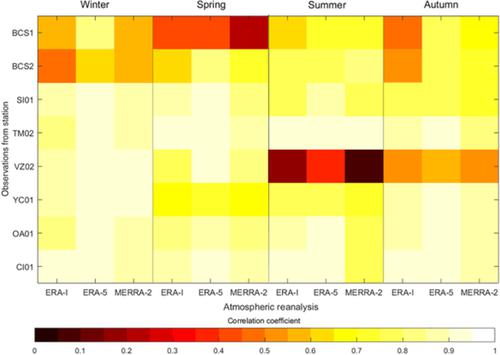当前位置:
X-MOL 学术
›
Meteorol. Appl.
›
论文详情
Our official English website, www.x-mol.net, welcomes your
feedback! (Note: you will need to create a separate account there.)
How well do atmospheric reanalyses reproduce observed winds in coastal regions of Mexico?
Meteorological Applications ( IF 2.3 ) Pub Date : 2021-09-07 , DOI: 10.1002/met.2023 Simon R. Thomas 1, 2 , Susie Nicolau 3 , Oscar Martínez‐Alvarado 1, 4 , Daniel J. Drew 5 , Hannah C. Bloomfield 4
Meteorological Applications ( IF 2.3 ) Pub Date : 2021-09-07 , DOI: 10.1002/met.2023 Simon R. Thomas 1, 2 , Susie Nicolau 3 , Oscar Martínez‐Alvarado 1, 4 , Daniel J. Drew 5 , Hannah C. Bloomfield 4
Affiliation

|
Atmospheric reanalyses are widely used for understanding the past and present climate. They have become increasingly used within the renewable energy sector for assessing wind and solar resources for different regions of the globe in conjunction with observations. Mexico is a country with considerable potential for wind energy production, especially around coastal sites and therefore the characterization of wind resource in these areas of the country is imperative for the most beneficial use of these resources. In this study, we assess how well three global reanalyses, namely ERA-Interim, ERA5 and MERRA-2, can reproduce wind observations at a number of key sites across the country. We find that the reanalyses' ability to reproduce these observations is highly variable between different regions in Mexico. Correlation coefficients are around 0.9 in the south of the country where the winds are strongest, but much lower (around 0.5) in Baja California Sur due to the complex coastal topography of the region. ERA5 outperforms ERA-Interim and MERRA-2 consistently across the vast majority of sites and so this reanalysis is recommended for local wind power studies. The consistently improved performance compared with ERA-Interim shows the value of the increased spatial resolution of ERA5. However, in the south and east of Mexico, despite having the highest correlations, ERA5 also has the largest bias, meaning that it underestimates winds consistently across most of the country. Poor correlations between ERA5 and the observations in Veracruz are considered as a case study to understand potential drivers of low wind biases.
中文翻译:

大气再分析如何再现墨西哥沿海地区观测到的风?
大气再分析被广泛用于了解过去和现在的气候。它们越来越多地用于可再生能源部门,结合观测评估全球不同地区的风能和太阳能资源。墨西哥是一个具有相当大的风能生产潜力的国家,尤其是在沿海地区,因此对该国这些地区的风资源进行表征对于最有益地利用这些资源至关重要。在这项研究中,我们评估了三个全球再分析,即 ERA-Interim、ERA5 和 MERRA-2,在全国多个关键地点再现风观测的效果。我们发现,重新分析再现这些观察结果的能力在墨西哥不同地区之间存在很大差异。相关系数在 0 左右。9 在该国南部风力最强,但由于该地区复杂的沿海地形,南下加利福尼亚州的风力要低得多(约 0.5)。ERA5 在绝大多数站点上始终优于 ERA-Interim 和 MERRA-2,因此建议将这种再分析用于当地风电研究。与 ERA-Interim 相比持续改进的性能显示了 ERA5 增加的空间分辨率的价值。然而,在墨西哥南部和东部,尽管相关性最高,但 ERA5 的偏差也最大,这意味着它始终低估了该国大部分地区的风。ERA5 与韦拉克鲁斯观测值之间的相关性较差,被认为是了解低风偏的潜在驱动因素的案例研究。但由于该地区复杂的沿海地形,南下加利福尼亚州要低得多(约 0.5)。ERA5 在绝大多数站点上始终优于 ERA-Interim 和 MERRA-2,因此建议将这种再分析用于当地风电研究。与 ERA-Interim 相比持续改进的性能显示了 ERA5 增加的空间分辨率的价值。然而,在墨西哥南部和东部,尽管相关性最高,但 ERA5 的偏差也最大,这意味着它始终低估了该国大部分地区的风。ERA5 与韦拉克鲁斯观测值之间的相关性较差,被认为是了解低风偏的潜在驱动因素的案例研究。但由于该地区复杂的沿海地形,南下加利福尼亚州要低得多(约 0.5)。ERA5 在绝大多数站点上始终优于 ERA-Interim 和 MERRA-2,因此建议将这种再分析用于当地风电研究。与 ERA-Interim 相比持续改进的性能显示了 ERA5 增加的空间分辨率的价值。然而,在墨西哥南部和东部,尽管相关性最高,但 ERA5 的偏差也最大,这意味着它始终低估了该国大部分地区的风。ERA5 与韦拉克鲁斯观测值之间的相关性较差,被认为是了解低风偏的潜在驱动因素的案例研究。ERA5 在绝大多数站点上始终优于 ERA-Interim 和 MERRA-2,因此建议将这种再分析用于当地风电研究。与 ERA-Interim 相比持续改进的性能显示了 ERA5 增加的空间分辨率的价值。然而,在墨西哥南部和东部,尽管相关性最高,但 ERA5 的偏差也最大,这意味着它始终低估了该国大部分地区的风。ERA5 与韦拉克鲁斯观测值之间的相关性较差,被认为是了解低风偏的潜在驱动因素的案例研究。ERA5 在绝大多数站点上始终优于 ERA-Interim 和 MERRA-2,因此建议将这种再分析用于当地风电研究。与 ERA-Interim 相比持续改进的性能显示了 ERA5 增加的空间分辨率的价值。然而,在墨西哥南部和东部,尽管相关性最高,但 ERA5 的偏差也最大,这意味着它始终低估了该国大部分地区的风。ERA5 与韦拉克鲁斯观测值之间的相关性较差,被认为是了解低风偏的潜在驱动因素的案例研究。然而,在墨西哥南部和东部,尽管相关性最高,但 ERA5 的偏差也最大,这意味着它始终低估了该国大部分地区的风。ERA5 与韦拉克鲁斯观测值之间的相关性较差,被认为是了解低风偏的潜在驱动因素的案例研究。然而,在墨西哥南部和东部,尽管相关性最高,但 ERA5 的偏差也最大,这意味着它始终低估了该国大部分地区的风。ERA5 与韦拉克鲁斯观测值之间的相关性较差,被认为是了解低风偏的潜在驱动因素的案例研究。
更新日期:2021-09-08
中文翻译:

大气再分析如何再现墨西哥沿海地区观测到的风?
大气再分析被广泛用于了解过去和现在的气候。它们越来越多地用于可再生能源部门,结合观测评估全球不同地区的风能和太阳能资源。墨西哥是一个具有相当大的风能生产潜力的国家,尤其是在沿海地区,因此对该国这些地区的风资源进行表征对于最有益地利用这些资源至关重要。在这项研究中,我们评估了三个全球再分析,即 ERA-Interim、ERA5 和 MERRA-2,在全国多个关键地点再现风观测的效果。我们发现,重新分析再现这些观察结果的能力在墨西哥不同地区之间存在很大差异。相关系数在 0 左右。9 在该国南部风力最强,但由于该地区复杂的沿海地形,南下加利福尼亚州的风力要低得多(约 0.5)。ERA5 在绝大多数站点上始终优于 ERA-Interim 和 MERRA-2,因此建议将这种再分析用于当地风电研究。与 ERA-Interim 相比持续改进的性能显示了 ERA5 增加的空间分辨率的价值。然而,在墨西哥南部和东部,尽管相关性最高,但 ERA5 的偏差也最大,这意味着它始终低估了该国大部分地区的风。ERA5 与韦拉克鲁斯观测值之间的相关性较差,被认为是了解低风偏的潜在驱动因素的案例研究。但由于该地区复杂的沿海地形,南下加利福尼亚州要低得多(约 0.5)。ERA5 在绝大多数站点上始终优于 ERA-Interim 和 MERRA-2,因此建议将这种再分析用于当地风电研究。与 ERA-Interim 相比持续改进的性能显示了 ERA5 增加的空间分辨率的价值。然而,在墨西哥南部和东部,尽管相关性最高,但 ERA5 的偏差也最大,这意味着它始终低估了该国大部分地区的风。ERA5 与韦拉克鲁斯观测值之间的相关性较差,被认为是了解低风偏的潜在驱动因素的案例研究。但由于该地区复杂的沿海地形,南下加利福尼亚州要低得多(约 0.5)。ERA5 在绝大多数站点上始终优于 ERA-Interim 和 MERRA-2,因此建议将这种再分析用于当地风电研究。与 ERA-Interim 相比持续改进的性能显示了 ERA5 增加的空间分辨率的价值。然而,在墨西哥南部和东部,尽管相关性最高,但 ERA5 的偏差也最大,这意味着它始终低估了该国大部分地区的风。ERA5 与韦拉克鲁斯观测值之间的相关性较差,被认为是了解低风偏的潜在驱动因素的案例研究。ERA5 在绝大多数站点上始终优于 ERA-Interim 和 MERRA-2,因此建议将这种再分析用于当地风电研究。与 ERA-Interim 相比持续改进的性能显示了 ERA5 增加的空间分辨率的价值。然而,在墨西哥南部和东部,尽管相关性最高,但 ERA5 的偏差也最大,这意味着它始终低估了该国大部分地区的风。ERA5 与韦拉克鲁斯观测值之间的相关性较差,被认为是了解低风偏的潜在驱动因素的案例研究。ERA5 在绝大多数站点上始终优于 ERA-Interim 和 MERRA-2,因此建议将这种再分析用于当地风电研究。与 ERA-Interim 相比持续改进的性能显示了 ERA5 增加的空间分辨率的价值。然而,在墨西哥南部和东部,尽管相关性最高,但 ERA5 的偏差也最大,这意味着它始终低估了该国大部分地区的风。ERA5 与韦拉克鲁斯观测值之间的相关性较差,被认为是了解低风偏的潜在驱动因素的案例研究。然而,在墨西哥南部和东部,尽管相关性最高,但 ERA5 的偏差也最大,这意味着它始终低估了该国大部分地区的风。ERA5 与韦拉克鲁斯观测值之间的相关性较差,被认为是了解低风偏的潜在驱动因素的案例研究。然而,在墨西哥南部和东部,尽管相关性最高,但 ERA5 的偏差也最大,这意味着它始终低估了该国大部分地区的风。ERA5 与韦拉克鲁斯观测值之间的相关性较差,被认为是了解低风偏的潜在驱动因素的案例研究。











































 京公网安备 11010802027423号
京公网安备 11010802027423号